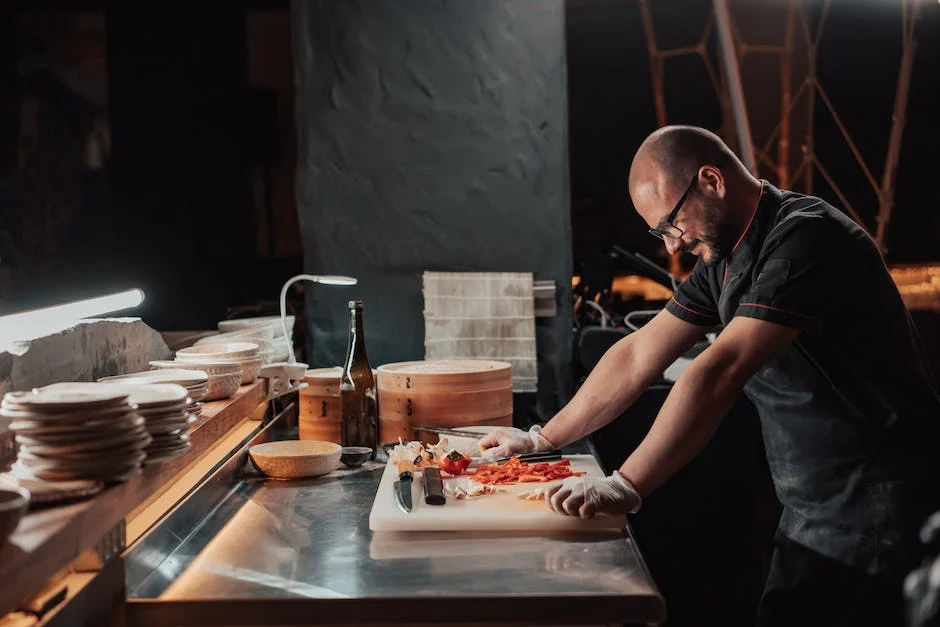Introduction to chef knives and their importance in the kitchen
Chef knives are the backbone of any kitchen, and understanding their different types and uses is essential for any aspiring chef. These versatile tools come in various shapes and sizes, each designed for specific tasks. From the classic chef’s knife with its wide blade and curved edge for chopping and slicing, to the nimble paring knife for intricate work, each knife has its purpose. The right knife can make all the difference in the efficiency and precision of your cooking. By delving into the world of chef knives, you can elevate your culinary skills and tackle any recipe with confidence.

Understanding the different types of chef knives
and their uses is essential for any aspiring chef or home cook. Each type of chef knife is designed for specific tasks, and knowing which knife to use can greatly improve your efficiency and precision in the kitchen. The most common types of chef knives include the chef’s knife, the Santoku knife, the paring knife, and the bread knife. The chef’s knife is a versatile all-purpose knife that can be used for chopping, slicing, and dicing. The Santoku knife, with its shorter and wider blade, is perfect for precision slicing and dicing of vegetables and fish. The paring knife is ideal for peeling, trimming, and intricate tasks. Lastly, the bread knife with its serrated edge is designed for slicing through crusty bread without squishing it. By understanding the different types of chef knives and their uses, you can elevate your culinary skills and create beautiful and delicious meals.
The chef’s knife: The all-purpose knife for everyday use
The chef’s knife is an essential tool in any kitchen and is often considered the workhorse of the culinary world. Its versatile design and sharp blade make it the go-to knife for a wide range of tasks. From chopping vegetables to slicing meat, the chef’s knife can do it all. Its curved blade allows for a smooth rocking motion, making it perfect for mincing herbs and garlic. The weight and balance of the knife provide control and precision, ensuring clean and even cuts. Whether you’re a professional chef or a home cook, having a high-quality chef’s knife is a game-changer in the kitchen.
The paring knife: Perfect for precision tasks and small ingredients
The paring knife is a versatile and essential tool in any chef’s arsenal. Its small size and sharp, narrow blade make it perfect for precision tasks and handling small ingredients. Whether you’re peeling fruits and vegetables, deveining shrimp, or trimming herbs, the paring knife allows for intricate and delicate cuts with utmost control. Its pointed tip also comes in handy for removing seeds or creating decorative garnishes. Don’t be fooled by its size; the paring knife is a powerhouse when it comes to tackling intricate kitchen tasks and ensuring precision in your culinary creations.
The utility knife: Versatile and handy for various cutting tasks
The utility knife is a must-have tool for any chef or home cook. Its versatility and handy size make it perfect for a wide range of cutting tasks in the kitchen. With a blade typically around 4-6 inches long, the utility knife is smaller than a chef’s knife but larger than a paring knife, making it ideal for slicing, dicing, and chopping fruits, vegetables, and herbs. Its straight edge allows for precise and controlled cuts, while its pointed tip can be used for more delicate tasks like removing seeds or trimming fat. Whether you’re preparing a salad, trimming meat, or slicing sandwiches, the utility knife is an essential tool that will make your cooking experience much more efficient and enjoyable.
The boning knife: Ideal for removing bones from meat and fish
The boning knife is an essential tool for any professional chef or home cook who wants to master the art of meat and fish preparation. Its narrow, sharp blade allows for precise and effortless boning, making it the ideal choice when removing bones from cuts of meat or filleting fish. The flexibility of the blade allows for easy maneuverability around joints and bones, ensuring minimal waste and maximum yield. Additionally, the boning knife can also be used for delicate tasks such as trimming fat and skin, further showcasing its versatility in the kitchen. Whether you’re a meat lover or a seafood enthusiast, understanding the different types of chef knives and their uses is crucial for achieving professional-level results in your culinary endeavors.
The bread knife: Serrated blade for effortless slicing of bread and pastries
The bread knife is a must-have tool for any kitchen, especially if you enjoy baking or working with pastries. Its serrated blade is specifically designed to effortlessly slice through bread and pastries without crushing or tearing them. The sharp teeth of the blade grip the crust of the bread, allowing for smooth and clean cuts. This type of knife is also great for slicing delicate cakes and pastries, as the serrations prevent the blade from dragging or squishing the layers. Whether you’re a professional baker or an avid home cook, a bread knife is an essential tool that will make your baking experience much more enjoyable and your results much more professional.
The Santoku knife: A Japanese knife for slicing, dicing, and chopping
The Santoku knife is a versatile Japanese knife that excels in slicing, dicing, and chopping tasks. While it may seem similar to a Western chef’s knife, the Santoku knife has unique features that set it apart. Its shorter and wider blade allows for precise control and easy maneuverability, making it perfect for handling a variety of ingredients. The word “Santoku” translates to “three virtues,” referring to its ability to perform three essential kitchen tasks—slicing, dicing, and chopping. Whether you’re preparing vegetables, meats, or fish, the Santoku knife’s sharp edge and ergonomic design make it an indispensable tool in any kitchen.
The cleaver: Heavy-duty knife for chopping through bones and tough ingredients
The cleaver is a heavy-duty knife that is specifically designed for chopping through bones and tough ingredients. Its thick and sturdy blade, along with its weight, allows for maximum power and control when tackling tougher cutting tasks in the kitchen. The cleaver’s broad blade also makes it ideal for smashing garlic or ginger, as well as transferring chopped ingredients from the cutting board to the pan. While it may seem intimidating, understanding the proper techniques and uses for a cleaver can greatly enhance your culinary skills and efficiency in the kitchen.
Choosing the right chef knife for your needs and budget
Choosing the right chef knife for your needs and budget is essential for any home cook or professional chef. With so many options available, it can be overwhelming to find the perfect knife. Understanding the different types of chef knives and their uses can help you make an informed decision. From the versatile and all-purpose chef’s knife to the precision of a paring knife, each knife has its unique purpose and benefits. Consider factors such as blade material, handle comfort, and balance when selecting a chef knife. Investing in a high-quality knife that suits your cooking style will not only enhance your culinary skills but also make your time in the kitchen more enjoyable.


